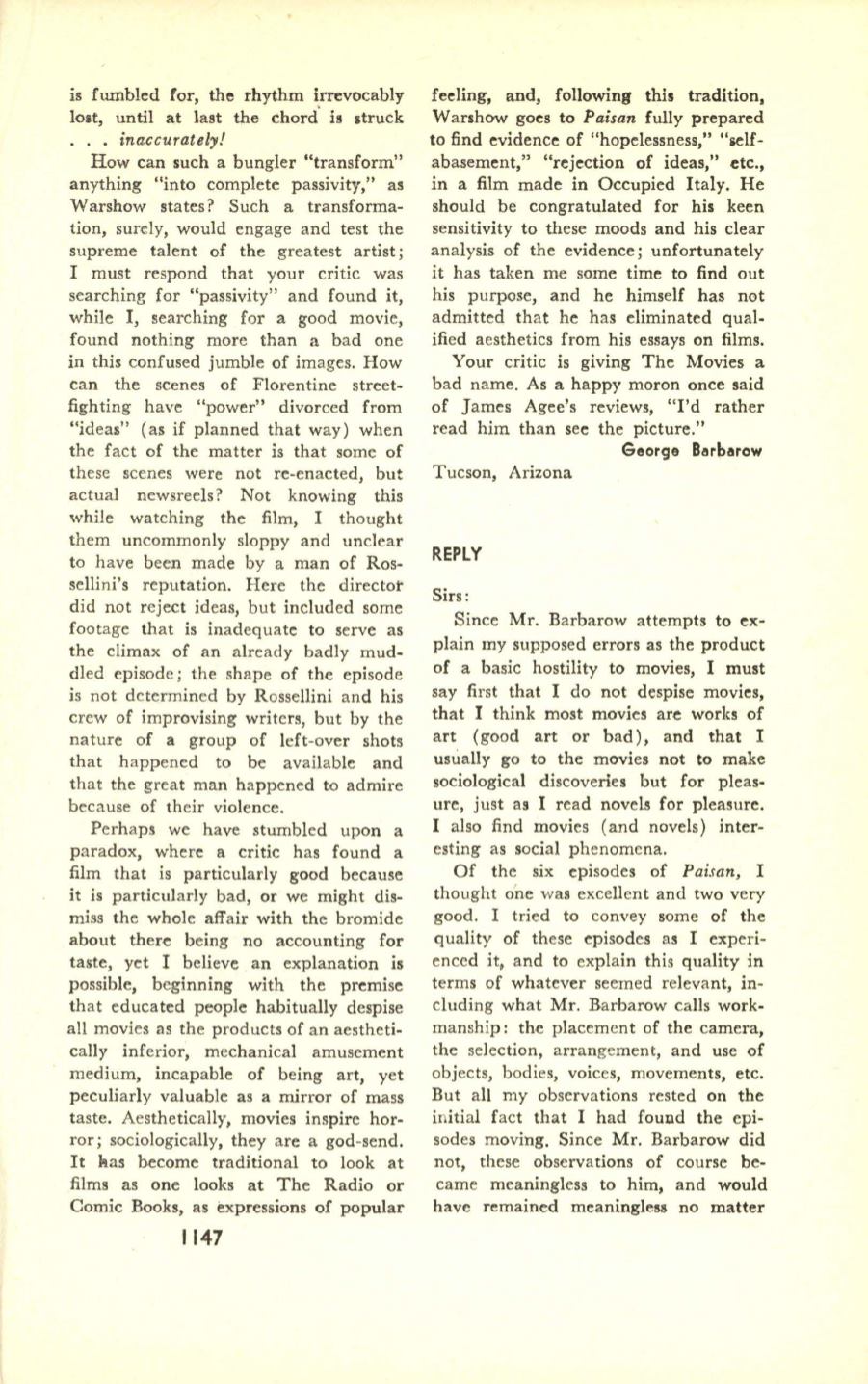
is fumbled for, the rhythm irrevocably
!oat, until at last the chord.
is
atruck
. . .
inaccuratel:y!
How can such a bungler "transform"
anything "into complete passivity," as
Warshow states? Such a transforma–
tion, surely, would engage and test the
supreme talent of the greatest artist;
I must respond that your critic was
searching for "passivity" and found it,
while I, searching for a good movie,
found nothing more than a bad one
in this confused jumble of images. How
can the scenes of Florentine street–
fighting have "power" divorced from
"ideas" (as if planned that way) when
the fact of the matter is that some of
these scenes were not re-enacted, but
actual newsreels? Not knowing this
while watching the film, I thought
them uncommonly sloppy and unclear
to have been made by a man of Ros–
sellini's reputation. Here the director
did not reject ideas, but included some
footage that is inadequate to serve as
the climax of an already badly mud–
dled episode; the shape of the episode
is not determined by Rossellini and his
crew of improvising writers, but by the
nature of a group of left-over shots
that happened to be available and
that the great man happened to admire
because of their violence.
Perhaps we have stumbled upon a
paradox, where a critic has found a
film that is particularly good because
it is particularly bad, or we might dis–
miss the whole affair with the bromide
about there being no accounting for
taste, yet I believe an explanation is
possible, beginning with the premise
that educated people habitually despise
all movies as the products of an aestheti–
cally inferior, mechanical amusement
medium, incapable of being art, yet
peculiarly valuable as a mirror of mass
taste. Aesthetically, movies inspire hor–
ror; sociologically, they are a god-send.
It .has become traditional to look at
films as one looks at The Radio or
Comic Books, as expressions of popular
1147
feeling, and, following this tradition,
Warshow goes to
Paisan
fully prepared
to find evidence of "hopelessness,"
"~telf
abasement," "rejection of ideas," etc.,
in a film made in Occupied Italy. He
should be congratulated for his keen
sensitivity to these moods and his clear
analysis of the evidence; unfortunately
it has taken me some time to find out
his purpose, and he himself has not
admitted that he has eliminated qual–
ified aesthetics from his essays on films.
Your critic is giving The Movies a
bad name. As a happy moron once said
of James Agee's reviews, "I'd rather
read him than see the picture."
George Barbarow
Tucson, Arizona
REPLY
Sirs:
Since Mr. Barbarow attempts to ex–
plain my supposed errors as the product
of a basic hostility to movies, I must
say first that I do not despise movies,
that I think most movies are works of
art (good art or bad), and that I
usually go to the movies not to make
sociological discoveries but for pleas–
ure, just as I read novels for pleasure.
I also find movies (and novels) inter–
esting as social phenomena.
Of the six episodes of
Paisan,
I
thought one was excellent and two very
good. I tried to convey some of the
quality of these episodes as I experi–
enced it, and to explain this quality in
terms of whatever seemed relevant, in–
cluding what Mr. Barbarow calls work–
manship: the placement of the camera,
the selection, arrangement, and use of
objects, bodies, voices, movements, etc.
But all my observations rested on the
initial fact that I had found the epi–
sodes moving. Since Mr. Barbarow did
not, these observations of course be–
came meaningless to him, and would
have remained meaningless no matter


